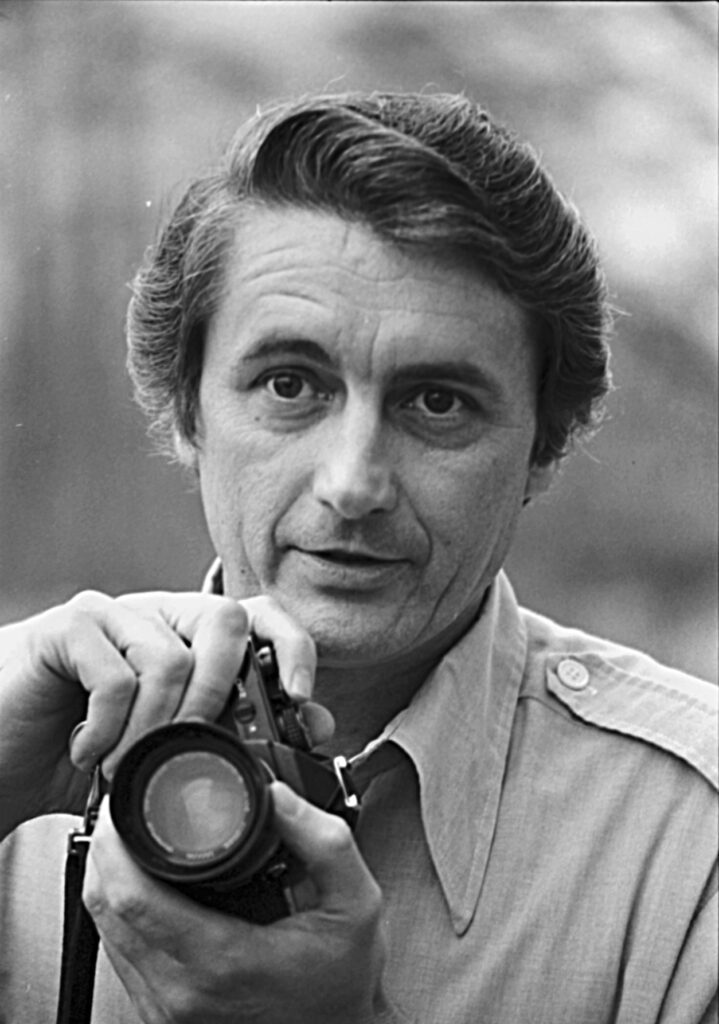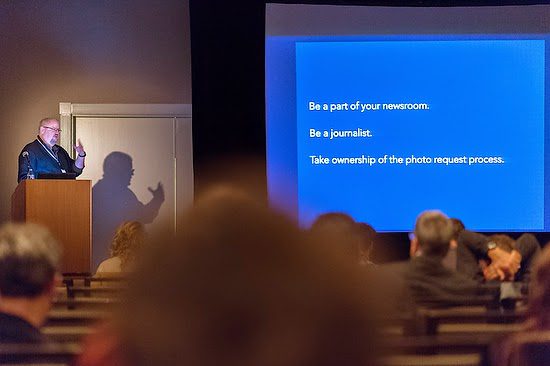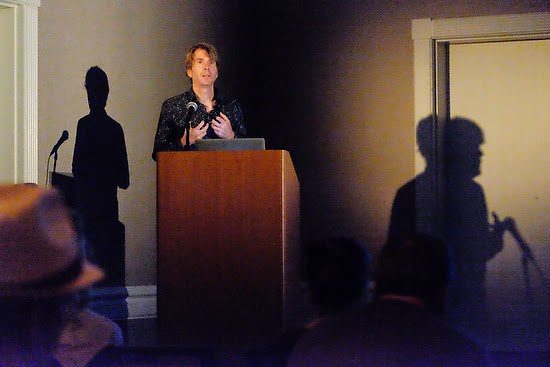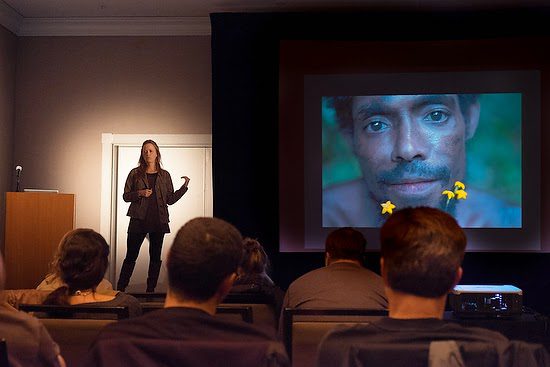| Nikon D4, 14-24mm, ISO 1600, ƒ/2.8, 1/160 |
Reconnecting is one of the best things for photographers when they go to conferences. Here you see Robert Seale talking with Andy Dunaway, the Nikon Representative, while Gladys and Frances are busy cleaning and checking in the background.
The expressions that capture why I attend these events yearly are what I like about the photo. Now, do I connect with everyone like this? No. I wish all conferences were more about relationships than just how good you are, what gear you own, or even where you work.
The Atlanta Photojournalism Seminar has been running continuously since 1973. My uncle Knolan Benfield was one of the organizers in those early years. To this day, I am still close to some of the founders, like Ken Touchton.

I have heard the stories about getting Eugene Smith to come and speak. My mentor Don Rutledge has a piece of paper framed with a photo of him meeting Eugene Smith. Don also presented that same year as Eugene Smith, which was 1975.
Don Rutledge was one of the 20 Black Star Photographers back during this time. He had better connections and could call many big names and ask them to speak at the seminar. Don is how they would get Howard Chapnick and others to talk in those early years.
Here is Don’s talk that year if you want to hear it: http://stanleyleary.com/DonRutledge/Don1.mp3
Here are a few more links to hear Don Rutledge:
http://stanleyleary.com/DonRutledge/DonRutledgeAudio.html
This photo is of Oliver Janney, a CNN photojournalist in the Washington bureau. His topic for his talk during the Friday workshops was “Shooting With Your Ears.”
He realized too many photographers who still add video/audio to their skills do not understand that audio is what drives a successful package. So he went over the gear and, more specifically, the audio equipment he uses daily in his work.
One of the tips I took from Oliver and a new technique to me was to “Lead with Audio.” You start the sound before you show the visual, which shows what is making that sound.
While some of what he said isn’t new to me, how he worded it was new. I loved his statement, “shooting audio without headphones will fail for the same reason when shooting video without looking at the screen.”
One last tip I might try as he would mic people with a wireless lavalier and then say he was going to shoot some b-roll for a moment. While shooting the b-roll, he was listening. If he heard them talk with good content, he would turn and shoot some more extended lens capture of the person but had great “real” audio of the person.
He also tries to interview people while they are working, if possible. Audio recording as they work tends to get them to be more natural.
Here is Jamie Squires, a Kansas City-based staff photographer for Getty specializing in Sports. I remember him as a student at Emory University back in the 1990s.
I noticed with Jamie’s successful images that they were not about just reacting to a moment. Instead, he had often arrived early and set up a remote camera, sometimes as much as 10 hours earlier to capture one shot.
He first understood the story and then would break down the day to the big moments. For example, he would know that the World Series final game celebration was typically between home plate and the pitcher’s mound, so he had one remote just on that area.
He knows someone will often get in between his camera and the play, so he also sets up remotes to cover this. But with all the remotes, he reminded everyone that remotes fail, and the one camera you must depend on is the one in your hands.
“GoPro: Dos, Don’ts, and Drones” was Eric Seals’s topic during the Friday Workshop. Eric is a staff photographer for the Detroit Free Press.
Eric is a gearhead who showed us all his toys and reminded us our gear would not hold the audience’s attention. The Story Matters Most.
Eric uses a gear to help leave visual breadcrumbs for his viewers. However, he also warned about overusing equipment, and your package will become gimmicky and lose your audience.
One thing that I could not agree more with Eric was how he emphasized knowing your gear. Read the manual, he said. Know what it can do and then take chances with it.
Miami photojournalist Al Diaz has been presented the Humanitarian Award by the National Press Photographers Association. He was given the award because of his actions to put the subject first and ensure a baby that had stopped breathing was taken care of before he picked up his cameras.
You can read more about this on NPPA’s website by going to this [link].
The best part of Al’s presentation was giving us the story behind the story.
When photographers share their work, the best thing they can do is to share the events surrounding the photograph and how they happened to be in that place at that time.
The other good thing about Al’s sharing is that it is therapeutic for everyone. He shared more images of the baby today being healthy. We learned the baby had a cyst in the throat, which has now been removed.
We also learned that to get the images and tell the story required a lot of people skills from Al Diaz and patience. Some of his friends helped him because the woman was upset with him for taking the photos. She didn’t even know he was the first person on the scene to call 911 and get the EMS to the location. Days later, she would put this together with Al in a meeting they had.
What did I learn? First, connect with people and develop a genuine relationship. Care for them as human beings, and then the story will tell itself.
Ken Lyons is Senior Photo Editor at The Denver Post. So why was he a speaker? Here is the text they used to promote him:
The Denver Post was recognized with the Angus McDougall Overall Excellence in Picture Editing Award in 2013. The Denver Post has recently been recognized with two feature photography Pulitzer Prizes. The staff received the Pulitzer Prize in 2013 for coverage of the Aurora Theater shootings. Other honors for his picture editing work include first and second place picture editing portfolio in the POYi editing competition. The newspaper has also been awarded first place Best Use of Photography in the Best of Photojournalism competition.
One thing I liked that they are doing at his paper is a ‘Photo Night.’ Photo Night is where they invite the public in one evening to listen to their photographers talk about stories that the public votes on to hear. The first few to arrive will win a signed print. Often they invite the subjects covered in the report to be a part of the evening.
Ken is all about elevating photojournalism in your community. I am now thinking of ways I can help do this with even corporations that I work with daily.
Scott Strazzante is a staff photographer at the San Francisco Chronicle, where he recently started working after a 13-year stint at the Chicago Tribune.
My favorite thing about Scott’s career is Common Ground–a personal project on transforming a piece of land in suburban Chicago from rural to suburban. He took photos of a farmer who lost his farm and then, years later, went back and showed those living on that land in a subdivision.
Here is a trailer that tells you a little about the project.
CBS News Sunday Morning just did a package on Scott this past Sunday.
Amy Toensing has been a regular contributor to National Geographic magazine for over a decade.
My takeaway from Amy is that we need to be curious. Her curiosity while shooting stories would lead to her discovering another story that she would then pitch to National Geographic Magazine and eventually shoot for them repeatedly.
She was shooting an assignment given to her in Australia when she asked herself who drew these stories on the rocks thousands of years ago. Then she met an aboriginal couple and realized they were a connection to the past. They had lived in the wilderness without clothing until World War II when the husband built a landing strip to help the Americans to fight the Japanese.
She also shared how this was an ongoing lifelong story for her.
Like Al Diaz, she put the subjects first. They even asked her to film a ceremony for them and not to publish it in the magazine. She honored their request and, because of it, deepened the relationship with the community.
My Tip To You
Go to conferences and take notes. Learn from others and get inspired. But remember most of all that it isn’t about the gear or you capturing images–it is about the relationships you develop with the subjects that you then share with your audience.










